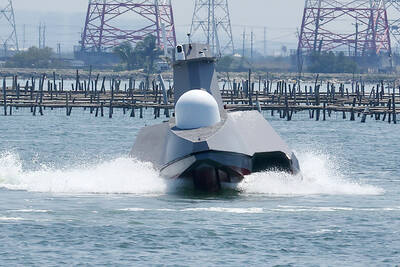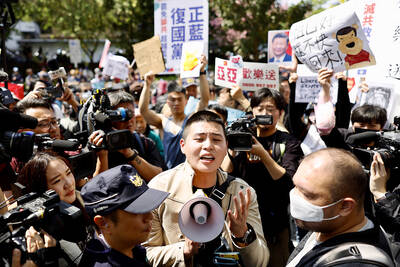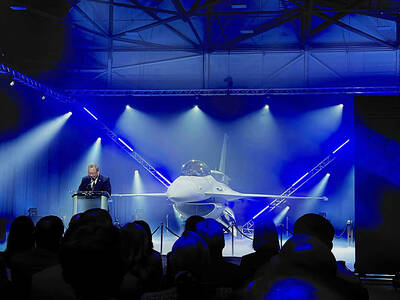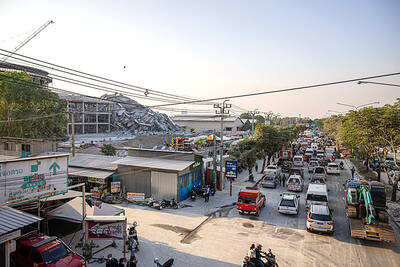China's military advantage in the Taiwan Strait continues to grow, but the Legislative Yuan's decision last year to boost defense spending will help right the balance, the Pentagon said in its annual review of China's military released in Washington on Monday.
China has been able to improve its overall military capabilities and the capabilities of its forces facing Taiwan, and continues to build up its array of short-range ballistic missiles aimed at Taiwan, the report said.
But the document disagrees sharply with President Chen Shui-bian (
US military analysts now say that China has deployed between 990 and 1,070 missiles against Taiwan, up from the 875 to 975 it estimated in last year's report. China is increasing the number of missiles by more than 100 a year, it says.
But that is still far below the more than 1,300 missiles that Chen has cited in statements over the past year.
CONCERNS
In a press briefing accompanying the release of the report, the Deputy Assistant Secretary of Defense for East Asia, David Sedney, said the missile deployment is "clearly an issue that we're very concerned about and which we have raised very strongly and consistently at high levels over the years with the Chinese."
But he had praise for Taiwan for increasing defense spending in response to the growing Chinese threat.
"We were very pleased this year that Taiwan passed ... in December a 2008 budget which increased rather substantially the amount of money and the percentage of its resources that Taiwan will be spending in its own defense. And we think that's very important," Sedney said.
PROCUREMENT
He said a near-record number of planned US arms sales to Taiwan were announced last year.
Those included 12 P-3C anti-submarine aircraft and related items worth US$1.96 billion, state-of-the-art upgrades to Taiwan's Patriot 2 anti-missile batteries worth US$939 million, and several hundred AMRAAM and Maverick missiles for use with Taiwan's F-16 fighters worth US$421 million.
The report says the legislative action, the US arms sales commitments and recent steps the Taiwan military has taken to improve its operational capabilities "have, on the whole, reinforced Taiwan's natural defensive advantages in the face of Beijing's continuing military buildup."
"We've made a number of notifications ... about the weapons systems Taiwan will be acquiring and we think those will help address the issues of the balance in the Taiwan Straits [sic]," Sedney said.
"But that certainly won't address it completely because China continues both its modernization and its deployment of forces based on Taiwan ... and we continue to not just watch it carefully but to take all appropriate measures that we have to do to be prepared for any eventuality," he said.
Asked about figures in this and last year's reports that show an actual decline in the number of Chinese ground forces deployed in the Taiwan Strait area, as well as a sharp decline in the number of bombers and fighters within range of Taiwan, Sedney downplayed the changes.
"Those are things that can change very rapidly," he said. "The Chinese have a lot of resources throughout the country which they can deploy in the Taiwan Strait area and which they practice deploying on a regular basis."
"So if you're looking at the Taiwan Strait, we wouldn't look just at any one point in time. You know, we do look at what's based there. But it's important to remember there's even a larger number of assets there," he said.
David Helvey, the director of China, Taiwan and Mongolia affairs for the US-China Economic and Security Review Commission, who also addressed the briefing, added to Sedney's comments.
"As China's military forces improve ... you see the retirement of older platforms and airframes. So in some cases, you may see a decrement in total numbers, but you have a higher percentage of much more capable platforms and systems," Helvey said.
In the report, the Pentagon also noted favorably the development of the Hsiung Feng IIE cruise missile, announced during the Han Kuang exercise in April, with a 1,000km range that enables it to reach Hong Kong and Shanghai.
RESPONSE
The Mainland Affairs Council (MAC) yesterday urged the international community to pay close attention to China's rapid military buildup, saying the Taiwan Strait has become one of the major flashpoints in the world because of Beijing's military rise.
In its official statement, MAC said the Chinese arms expansion has not only tipped the balance of power in the East Asia, but also threatened the stability in the Pacific region.
Furthermore, Taiwan has reasons to believe that Beijing still views Taiwan as its greatest enemy. Such animosity is evident in the number of missiles, increasing at a rate of 100 missiles per year, pointed at the country.
MAC called on the international community to raise suspicion about the true intention behind Beijing's military buildup.
Additional reporting by Jenny W. Hsu

ENDEAVOR MANTA: The ship is programmed to automatically return to its designated home port and would self-destruct if seized by another party The Endeavor Manta, Taiwan’s first military-specification uncrewed surface vehicle (USV) tailor-made to operate in the Taiwan Strait in a bid to bolster the nation’s asymmetric combat capabilities made its first appearance at Kaohsiung’s Singda Harbor yesterday. Taking inspiration from Ukraine’s navy, which is using USVs to force Russia’s Black Sea fleet to take shelter within its own ports, CSBC Taiwan (台灣國際造船) established a research and development unit on USVs last year, CSBC chairman Huang Cheng-hung (黃正弘) said. With the exception of the satellite guidance system and the outboard motors — which were purchased from foreign companies that were not affiliated with Chinese-funded

PERMIT REVOKED: The influencer at a news conference said the National Immigration Agency was infringing on human rights and persecuting Chinese spouses Chinese influencer “Yaya in Taiwan” (亞亞在台灣) yesterday evening voluntarily left Taiwan, despite saying yesterday morning that she had “no intention” of leaving after her residence permit was revoked over her comments on Taiwan being “unified” with China by military force. The Ministry of the Interior yesterday had said that it could forcibly deport the influencer at midnight, but was considering taking a more flexible approach and beginning procedures this morning. The influencer, whose given name is Liu Zhenya (劉振亞), departed on a 8:45pm flight from Taipei International Airport (Songshan airport) to Fuzhou, China. Liu held a news conference at the airport at 7pm,

AIR SUPPORT: The Ministry of National Defense thanked the US for the delivery, adding that it was an indicator of the White House’s commitment to the Taiwan Relations Act Deputy Minister of National Defense Po Horng-huei (柏鴻輝) and Representative to the US Alexander Yui on Friday attended a delivery ceremony for the first of Taiwan’s long-awaited 66 F-16C/D Block 70 jets at a Lockheed Martin Corp factory in Greenville, South Carolina. “We are so proud to be the global home of the F-16 and to support Taiwan’s air defense capabilities,” US Representative William Timmons wrote on X, alongside a photograph of Taiwanese and US officials at the event. The F-16C/D Block 70 jets Taiwan ordered have the same capabilities as aircraft that had been upgraded to F-16Vs. The batch of Lockheed Martin

GRIDLOCK: The National Fire Agency’s Special Search and Rescue team is on standby to travel to the countries to help out with the rescue effort A powerful earthquake rocked Myanmar and neighboring Thailand yesterday, killing at least three people in Bangkok and burying dozens when a high-rise building under construction collapsed. Footage shared on social media from Myanmar’s second-largest city showed widespread destruction, raising fears that many were trapped under the rubble or killed. The magnitude 7.7 earthquake, with an epicenter near Mandalay in Myanmar, struck at midday and was followed by a strong magnitude 6.4 aftershock. The extent of death, injury and destruction — especially in Myanmar, which is embroiled in a civil war and where information is tightly controlled at the best of times —